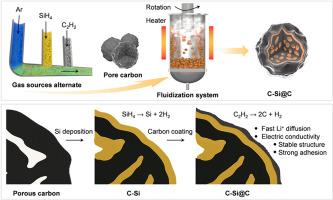Fluidization synthesis of silicon-nanocrystals embedded mesoporous carbon for high-performance lithium-ion batteriess
IF 11.6
2区 材料科学
Q1 CHEMISTRY, PHYSICAL
引用次数: 0
Abstract
Silicon carbon (Si/C) composites are widely regarded as leading anode candidates for high-energy-density power batteries in the path toward commercialization. However, the conventional preparation processes of nano-Si/carbon composites still face challenges such as severe agglomeration and uneven distribution of nano-Si, insufficient conductive interface contact, and severe volume expansion during cycling. In this work, we propose a strategy for the fabrication of Si-nanocrystal/carbon composites by sequential fluidized chemical vapor deposition (CVD) of silane (SiH4) and acetylene (C2H2) within porous carbon materials. Taking advantage of the high-temperature decomposition of SiH4, nano-sized Si-crystallites (<5 nm) are uniformly deposited inside the porous carbon matrix, which enhances the interfacial contact in Si/C composites and improving the electron/ion transport kinetics. An optimally regulated C2H2-derived carbon coating further stabilizes the electrode structure and effectively mitigates the volume expansion of Si. Meanwhile, the fluidized engineering approach strengthens the mass transfer rate during the fabrication process, thereby shortening the manufacturing time and improving the uniformity of Si-nanocrystal deposition. The as-prepared Si-nanocrystal/carbon composites, when applied as anode materials for lithium-ion batteries, exhibit excellent electrochemical performance. The composite delivers an initial coulombic efficiency (ICE) of 76 % at a current density of 0.3 A g−1 and maintains a reversible capacity of 733.6 mAh g−1 after 100 cycles. The effective adoption of this approach provides a novel route toward the commercialization of Si/C anode materials.

高性能锂离子电池用嵌入介孔碳的硅纳米晶流态化合成
硅碳(Si/C)复合材料被广泛认为是高能量密度动力电池商业化道路上的主要阳极候选材料。然而,传统的纳米硅/碳复合材料制备工艺仍然面临着纳米硅团聚严重、分布不均匀、导电界面接触不足、循环过程中体积膨胀严重等挑战。在这项工作中,我们提出了一种在多孔碳材料中通过硅烷(SiH4)和乙炔(C2H2)的顺序流化化学气相沉积(CVD)制备硅纳米晶/碳复合材料的策略。利用SiH4的高温分解,在多孔碳基体内均匀沉积纳米级Si晶(< 5nm),增强了Si/C复合材料的界面接触,改善了电子/离子的传递动力学。优化调节的c2h2衍生碳涂层进一步稳定了电极结构,并有效减轻了Si的体积膨胀。同时,流化工程方法加强了制备过程中的传质速率,从而缩短了制备时间,提高了硅纳米晶沉积的均匀性。制备的硅纳米晶/碳复合材料作为锂离子电池负极材料,具有优异的电化学性能。该复合材料在0.3 a g−1电流密度下的初始库仑效率(ICE)为76%,在100次循环后保持733.6 mAh g−1的可逆容量。这种方法的有效采用为硅/碳阳极材料的商业化提供了一条新的途径。
本文章由计算机程序翻译,如有差异,请以英文原文为准。
求助全文
约1分钟内获得全文
求助全文
来源期刊

Carbon
工程技术-材料科学:综合
CiteScore
20.80
自引率
7.30%
发文量
0
审稿时长
23 days
期刊介绍:
The journal Carbon is an international multidisciplinary forum for communicating scientific advances in the field of carbon materials. It reports new findings related to the formation, structure, properties, behaviors, and technological applications of carbons. Carbons are a broad class of ordered or disordered solid phases composed primarily of elemental carbon, including but not limited to carbon black, carbon fibers and filaments, carbon nanotubes, diamond and diamond-like carbon, fullerenes, glassy carbon, graphite, graphene, graphene-oxide, porous carbons, pyrolytic carbon, and other sp2 and non-sp2 hybridized carbon systems. Carbon is the companion title to the open access journal Carbon Trends. Relevant application areas for carbon materials include biology and medicine, catalysis, electronic, optoelectronic, spintronic, high-frequency, and photonic devices, energy storage and conversion systems, environmental applications and water treatment, smart materials and systems, and structural and thermal applications.
 求助内容:
求助内容: 应助结果提醒方式:
应助结果提醒方式:


